Expert Interviews
- University Reviews
- Career Guide
 Video Counseling
Video CounselingImportant Facts
- Ask any Question - CV Forum

LayOffs- Meaning, Reasons, Latest News and What to do Next?
College Vidya Team Jan 11, 2025 10.9K Reads

A layoff is a word that can set off a trail of nervousness down the spines of employees in an organization. But what exactly is the meaning of a layoff? And how is it different from getting fired? Most importantly, what can you do to avoid the cut? What to do next if a layoff seems inevitable at your current corporate job?
If these are some of the questions that have you wondering, then you are at the right spot as we will answer all such questions of yours here in this detailed blog. Keep reading to find out the definition of a layoff, the latest news from the industry about layoffs, reasons for layoffs, and alternatives to a layoff.
Here we have curated all crucial aspects of a layoff that you should know to smoothly navigate through it if the situation arises.
What is a Layoff? Definition, Meaning, Types
To set off, the very first aspect is to understand what exactly a layoff means. While there are many interrelated terms for layoff, there are slight differences between all of them. Here is the meaning of a layoff.
According to the Cambridge dictionary, a layoff is when a company or employer “stops employing someone, sometimes temporarily, because the company does not have enough money or work”.
So, in the simplest terms, a layoff is when the company or your employer puts either a temporary halt or a permanent termination on your employment with the organization. While the reasons for a layoff can be many, almost none of them include any fault of the employees. Rather, a layoff is conducted mostly due to factors that pertain to the company or the employer. Layoffs can be temporary (in which case the employee usually receives a compensatory amount until their tenure rebegins) or permanent (which means a termination of the service of the employee with the company).
The latest example of layoffs can be the humongous layoffs in 2022 by tech giant Meta, in which over 11,000 employees, constituting about 13% of its workforce, faced the cut.
Layoffs can be of many types, here we have mentioned some of the most commonly seen types of layoffs for you:
- Mass Layoff: This is one of the most common types of layoff in which a company lays off a large number of employees in a single go, such as over 500 employees being laid off in less than 30 days.
- Temporary Layoff: A layoff is said to be a temporary one when the tenure of an employee with the company is not terminated but halted for some time. In a temporary layoff, the company provides the employee with some compensatory benefits insurance and cover, compensatory pay (usually a certain percentage of the base salary), perks and benefits, etc. An employee who has been temporarily laid off can be called back for work after a leave of absence, as per the company’s need.
- Permanent Layoff: A permanent layoff means that the tenure of the employee with the company has been indefinitely terminated by the employer, without any fault of the employee. The reasons for a permanent layoff are related to the employer and the company’s needs.
- Voluntary Layoff: Unlike the other types of layoff, in a voluntary layoff, an employee decides to give up perks and benefits or their job position voluntarily, usually upon the request of the employer or in exchange for a severance package. This includes giving a voluntary resignation or taking a voluntary retirement from work.
Layoff vs Furlough vs Firing: Difference and Meanings
As already discussed above, a layoff is a temporary (or in other cases, a permanent) halt of an employee’s professional engagement with a company which is initiated by the employer, mostly without any fault of the employee.
But two closely related (and much confused between) terms are furloughs and firing. So is a layoff different from these two? Here we have it broken down for you-
Video Source: Firstpost
Layoff vs Furlough
A furlough is a temporary leave of absence that an employee goes through, usually initiated by the employer (or sometimes upon request by the employee). In a furlough, the employee is expected to return to work soon and the leave of absence is temporary. During this period, the employee continues to receive major benefits like health coverage, insurance, etc. from the company. But in the case of a layoff, it is more likely to be permanent than temporary. Even in the case of temporary layoffs, the benefits and severance compensation offered to the employee are mostly dependent on the company’s policies and decisions based on their needs.
So, in essence, a furlough is like an unpaid leave of absence from work wherein you are eventually expected to return, but a layoff is like a temporary or permanent halt of the tenure of an employee with the organization.

Layoff vs Firing
The main difference between a layoff and firing is the cause for termination of the employee’s tenure. A layoff is mainly conducted for reasons and factors related to the employer or company such as reduction of costs, lack of work, relocation of company site, change in work requirements/job positions, etc. So, it can be said that reasons for a layoff rarely include any fault of the employee.
On the other hand, a firing is conducted mainly based on factors related to an employee such as poor conduct at the workplace, low productivity or poor work performance, misconduct and insubordination, etc. So, a firing is done by a company/employer usually in response to some employee behavior.
Common Abbreviations and Terms Related to LayOffs
Here are a few commonly used, technical terms that may be used in corporate or industrial sectors for a layoff (or related to layoffs):
- Furlough: A furlough is a temporary leave of absence of an employee from an organisation usually owing to lack of work or to reduce the costs to the company by the employer.
- Downsizing: Closely related to a layoff, downsizing refers to the termination of multiple employees (often in a single cut) to cut down costs and increase the profits of the organization. A downsizing refers to reducing the size of the workforce and is permanent.
- Firing: Firing is the termination of the tenure of an employee based on performance conduct or related concerns about the employee.
- RIF: This stands for Reduction in Force, and is a commonly used abbreviation related to Layoff. It refers to a reduction in the size of the workforce of an organization and is usually used in the context of armed forces.
- VRIF: This stands for a Voluntary Reduction in Force (VRIF) and is similar to a voluntary layoff. A VRIF is usually in the form of a resignation or voluntary retirement in exchange for a satisfactory severance package or the face of an imminent termination or layoff.
- Redundancy: Redundancy at the workplace refers to a situation when an employer has to temporarily halt or permanently terminate the employment of some members of the workforce. Although essentially similar to a layoff, the reasons for redundancy can include situational factors such as relocation of the company, etc. On the other hand, a layoff is mainly related to a lack of work or a reduction of costs by the company.
- Retrenchment: Although it quite literally means a reduction of expenses, in labor law and workplace studies, retrenchment refers to the process in which an employer cuts down the expenses of the company by terminating the services of employees. The main aim of retrenchment is the reduction in workforce size to increase the company’s profits.
Latest News and Statistics of Layoffs

- Pepsico Layoffs 2022: According to the Wall Street Journal (citing an internal memo), the beverage and snack company Pepsico has been reported as going through major layoffs in its headquarters, with over a hundred employees likely to be impacted by the slash.
- H&M December 2022 Layoff: H&M, which is the second largest global fashion retailer, has been reported to be planning the layoff of almost 1500 of its employees, which makes up for about 10% of its total workforce.
- Amazon November 2022 Layoff: Amazon announced in November 2022, that it will lay off about 10,000 of its employees (less than 1% of its global workforce), majorly from the Alexa division due to underperformance.
- Twitter November 2022 Layoff: Of late, the microblogging giant, Twitter has seen a whirlwind of layoffs, firings, and resignations from employees. The company, as of November 2022, has reportedly laid off over 50% of its workforce (around 3800 employees). In the latest news, Twitter continues to lay off its contractual workers as of December 2022.
- Meta November 2022 Layoff: In November 2022, the tech giant Meta laid off almost 11,000 employees, constituting around 13% of its workforce, closely after the major financial losses it faced.
- Microsoft December 2022 Layoff: As per recent reports by Axios, Microsoft is currently seeing the third round of layoffs in the last few months, with the slash affecting around 1000 employees of the organization as per an insider.
- Byju’s 2022 Layoff: The Indian edtech platform has recently announced a layoff of 5% of its workforce which is estimated to number around 2500 employees over the next 6 months as part of cutting its expenses.
- Unacademy November 2022 Layoff: The edtech firm Unacademy is undergoing a second layoff as of November 2022, which will include approximately 10% of its workforce (350 employees).
- HCL Technologies September 2022 Layoff: In September 2022, HCL, one of the tech giants of India, laid off about 350 of its employees who were employed on a Microsoft project.
- Phillips October 2022 Layoff: Phillips, an international electronics and electrical company, has laid off 4000 of its employees globally amid facing major lawsuits. This amounts to around 5% of the total workforce of the company.
Reasons for Layoffs
The reasons for a layoff usually revolve around a company’s inability to sustain the employment of certain employees either due to high costs or due to lack of work in the domain etc. However, in most cases, the reasons for a layoff include factors about the company rather than a specific employee.
Here we have listed some of the most common reasons why a company may choose to lay its employees off-
1. Cost Reduction
Cost reduction is one of the primary reasons why a layoff may occur in a company. Be it due to business losses or low profits, under average production, or to maximize profits, a company may choose to conduct a layoff. Sustaining an employee’s salary and other perks and benefits is one of the biggest expenses that a company has to bear, and as a result, they may have to choose to lay off employees in situations of economic losses or crises. This is one of the most common causes of layoffs during economic recessions.
2. Mergers and Buyouts
A merger is a situation in which a company/operating unit is merged with another company/operating unit to form a new company/unit. Similarly, a buyout (commonly called acquisition) is a situation where the ownership of a company/operating unit is transferred to another company to become its part owing to a purchase.
In both these situations, a layoff may occur because the newly formed company (or existing company that buys out another) may have altered job positions, staff requirements, job titles, etc. As a result, they may evaluate the current workforce and accordingly decide if all the previously employed people must be retained or can be laid off.
3. Layoffs due to Staff Redundancy
This is another common cause of layoffs. Staffing redundancies may include factors such as a change in job titles, redundant job positions that are no longer required, overstaffed departments, outsourcing of workforce, etc.
These factors may mean that a few employees of a company will lose their jobs and will have to be laid off since the company no longer has work to offer to them. They may be laid off temporarily due to current overstaffing or may do so permanently owing to a change in the company’s overall staff requirements.
4. Company Relocation
In some cases, when a company relocates itself to a new area or region, it may not prefer to afford the added expenses of transferring and relocating the current workforce to the new location. Rather, the company may choose to hire a new, local workforce at the new location to where they are shifting. In such a case, there may be mass layoffs to terminate the tenure of some employees.
5. Outsourcing Employees
This is one of the factors that leads to staff redundancy. These days, rather than hiring full-time employees under the company’s workforce, which often includes a large amount of expenses, many large companies are outsourcing their employees. This is usually done by contacting agencies for employees; these agencies have employees on their payroll and provide services to second parties. By doing so, the main company can reduce its workforce and hence lay off employees. The rising prevalence of outsourcing and agencies providing such services is one of the common causes of layoffs in today’s professional landscape.
6. Technological Advancement
This is a newly emerging reason for companies to rely less on their human resources. With several innovative technologies today such as Artificial Intelligence (AI) tools, technological advancements, and newer software and tools, the need for manual work has reduced manifold. As a result, with newer technologies replacing the human aspect of services and production, many companies have reduced dependence on a large workforce and can turn to layoffs as a measure to cut down their expenses while continuing to maximize profits.
7. Changes in Job Positions
This is another type of staff redundancy. With the changing needs of industries and corporations, while many new job positions and titles are emerging with innovative job roles, many already existing ones are becoming obsolete. Another situation when job positions could change is when a company ventures into a new field or changes its current direction of work. In such a case, some previous job positions and job roles may no longer be needed or be replaced with altered roles, and as a result, employees serving in such positions may be laid off, at least temporarily, by the company until they are needed again.
So, while the reasons for a layoff by a company may be numerous and varied, in some situations, it may be the most sensible or the only option for further action.
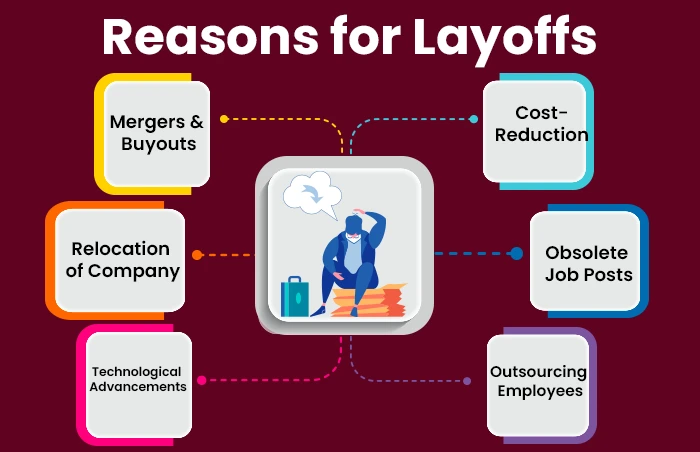
How to Avoid Layoffs?
Is there any way in which you can avoid bearing the brunt of layoffs at your current job? If a layoff is ultimately imminent, how to survive it?
Well, a layoff is surely a situation involving uncertainty about your future relationship with the company. However, there are certain aspects and factors to keep in mind if you wish to stand out from the rest of the workforce. Developing yourself and tailoring your job responsibilities in a certain way can help you avoid suffering a layoff.
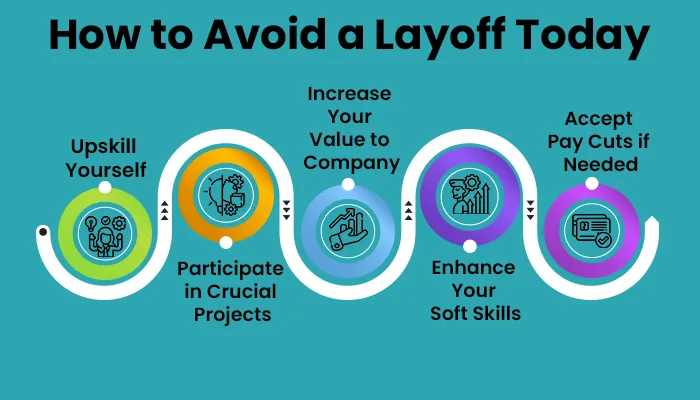
Here, we have listed down some of the factors you wish to keep in mind if you want to avoid suffering a layoff at your company:
1. Always Keep On Upskilling Yourself
In a VUCA professional environment- volatile, uncertain, complex and ambiguous, the nature of work is constantly changing. Not only are there new job roles and responsibilities emerging virtually every day, but the existing jobs are constantly evolving- they require the job holder to enhance their skills and knowledge to keep up with the changing pace of the industry.
Hence the one mantra to keep in mind is- never stop learning. Regularly upskilling yourself helps you stay relevant to your professional domain, and helps you a more crucial asset to the company. Continuous upskilling has become more convenient than ever today with a large number of top universities and higher education institutions offering upskilling courses specially designed for working professionals. Better still, there are diplomas, certificates as well as degree programs that can be pursued while working, through the online mode!

Lifelong learning is one of the key factors towards a successful career today, and hence it is understandably a factor that helps you avoid the slash when your company is looking for employees to lay off.
2. Become Indispensable to the Company
More than a measure you can take, this is an approach to maintain throughout your career if you want to build and grow it successfully. If you want to stand out from the rest of the workforce and get yourself noticed by the top management, you should work towards making yourself an indispensable asset to the company.
Whether it be through performing efficiently at your work goals, coordinating projects effectively, actively getting involved with work activities or maintaining a cordial work environment, you can increase your value to your company. And the more indispensable you are perceived as, the less likely you are to be laid off by your employer.
If you are perceived as an important asset to your company by the employer, then the chances that the company would want to lose you is lesser.
3. Get Involved with Big and Crucial Projects
This is a more strategic approach to take. When you participate or volunteer for crucial projects of the company, you become an important asset for the ongoing functioning of the company. On the other hand, when you are not involved with any major or complex company functions or projects or only involved with miniscule ones, the company is more likely to lay you off during a cut.
So, although seemingly tedious, actively participating in large or complex company projects may make you an indispensable asset to the company and help you avoid layoffs if the company conducts one.
4. Increase Your Skill Set & Widen Your Job Responsibilities
An effective way of avoiding layoffs is making yourself useful to the company in more than one domain. So, upskilling yourself becomes very relevant in this context as well. You can develop and learn new skills and job responsibilities related to your domain so that your importance for the company grows.
For example, if you are a graphic designer who is trained in the creation of both static and motion graphics instead of being trained only in the creation of static media, you are a more useful asset to your company and hence less likely to be laid off in case of a downsizing.
So, increasing your skill set and covering a wider range of job responsibilities is not only helpful for your future career prospects but also for avoiding layoffs as an employee at your current job.
5. Focus on Soft Skills
When it comes to evaluating which employee should be retained and who should be laid off, employers look not only for technical expertise but also effective soft skills that the employee possesses.
An employee who is a collaborator rather than a personal opportunist, who is a good communicator, professional, team-oriented, optimistic, and oriented towards conflict resolution gets leverage during various considerations for layoffs.
So, make sure you maintain a professional and cordial approach at the workplace, and hone your soft skills and competencies while growing your technical expertise as well.
6. Carefully Choose your Career Domain
Simply being put, some career domains have a larger scope than some others for future growth. While the future scope of a field may not be a guaranteed factor directly impacting layoffs in a firm, some fields are very likely to grow obsolete in the near future owing to latest technological advancements and development. As a result, if you have chosen your career in a field that is going to grow in the future, the chances of facing a mass layoff are less likely than if you are employed in a field that may get replaced by technology.
Fields like the Internet of things, digital marketing, data science, management, artificial intelligence, business analytics etc. are some of the quickly emerging fields in the Indian professional domain. Explore top online courses and degrees in management, IT, technology, and computer applications here!
|
Upskilling Programs |
||
|
Certificate In Cloud Computing |
||
7. Refine your Niche skills
Being good at what you do is a central aspect of your work efficiency, in addition to other factors like work pace, quantity of work, productivity, etc. Nuanced understanding and expertise of your relevant field is crucial to helping you avoid a layoff since it increases your importance to the employer and makes you less likely to be exempted.
You can find or carve a niche for yourself at your job and refine your knowledge of that domain, which will ultimately make you more indispensable to your organization. Explore a large number of specialisations in degree courses like MBA, MCA, MA, BBA, BCA and much more!
|
Degree Course for Working Professionals |
||
8. Settle for Pay Cuts/ Perks Cut if the need Arise
This is the last way to avoid being laid off and can be quite helpful in case a layoff is imminent. If you feel that you might be one of the employees being laid off by the company, then you can arrive at a middle road concerning the issue by possibly settling for an unpaid leave or partial pay or reduced benefits and perks.
These help the company to cut costs and reduce expenses while at the same time helping you to avoid a permanent layoff and keep your job, even if at the cost of a few unpaid days. Additionally, it helps to convey an optimistic message about your commitment to the company to your employer and can play off as a leveraging factor for you in future downsizing situations as well.
What to do Next?
In the case of an unavoidable layoff, there are certain things to keep in mind. Here we have listed some important do’s and don’ts to consider if you face a layoff at your job.
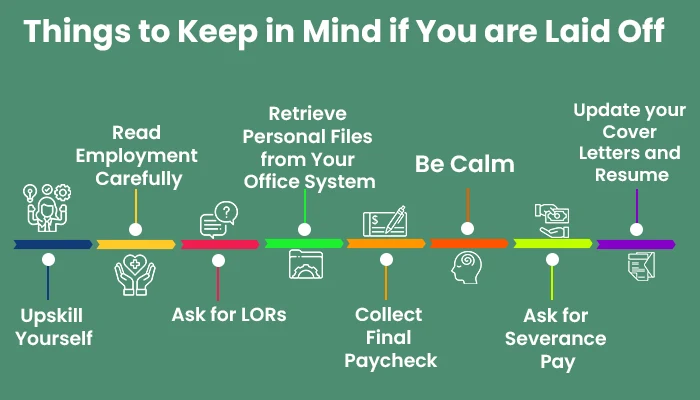
1. Retrieve important information and files from your system
If you have been laid off by your employer, make sure you go through your office system or devcountices (PC, Laptop, mobile devices, tablets etc.) to ensure that you don’t leave behind any confidential information related to your employment or work for others to access.
In the case of sensitive or confidential official information, retrieve the same and submit it to your employer/reporting head. In the case of personal information on your system, retrieve the files and remove them from your office system as it will eventually be accessed by other employees.
2. Carefully Read the Employment Agreement/Contract
In the case you have been laid off by your employer, it is advisable to carefully go through your employment contract and find out your rights and the procedure that you have to go through in the case of a layoff. It is essential to know the company policies and rules in case of a layoff so that you can ensure that your rightful benefits and compensation have been provided to you if you are one of the laid-off employees. Seek relevant information from the HR department of your company if the need arises.
3. Collect Final Paycheck
Gather information about the pay rules when it comes to a layoff from your Human Resource Department. Some companies may offer partial pay or a minimum support compensation to you on a monthly basis based on the years of your service in the company. Some companies may offer severance pay as compensation for your layoff, especially if it's a permanent layoff that you are facing. After acquainting with the policy of compensation for layoff, find out when you will receive your final paycheck. Some companies may give the paycheck after clearing your accounts with the company after a few days of your layoff. Some companies may do so on a more urgent basis or every month in the form of a partial allowance (in case of a temporary layoff).
To find out your company’s policy regarding the same and confirm when you shall receive your final paycheck.
4. Check for Severance Pay
When you are laid off by your employer, they will usually offer you some compensation in the form of perks or benefits or through partial pay. In either case, if you are laid off from your current job, you should ask your employer for your severance pay, which is provided as compensation for the layoff of an employee. Most companies have some existing policies in place for the severance pay of a laid-off employee.
5. Ask for Letters of Recommendation
Even if your company has laid you off from your service, you should keep in mind to make the most out of the situation for your future prospects and career development. You should ensure that you end on a good note with your seniors, and you can ask for references or letters of recommendation from your seniors, reporting head, or manager.
A letter of recommendation from your current employer helps to convey that you were efficient at your work and that you ended on cordial terms with your previous employer and colleagues.
6. Maintain a calm composure
A layoff is surely an anxiety-provoking situation wherein a large number of questions and queries are raised about your future status of employment with the current company as well as future job prospects. However, you should try to maintain a calm composure as it will help you to navigate through the entire procedure smoothly. There are a number of procedures and formalities involved in the process of a formal layoff and hence, maintaining a relaxed and calm approach will help you to carefully and mindfully complete them.
7. Upskill yourself to grow your skills and knowledge
In case you have been laid off from your current job, you should not see it as an end or setback to your future career prospects. While you are waiting for your current company to call you back for regular service or exploring new job avenues, you should also keep on growing your skills simultaneously.
Upskill, upskill, upskill!! We cannot emphasise this enough, but in a fast paced technology-driven professional world, it is extremely important to stay updated with trends and new developments in your field. Today, with technological support, you can complete degrees, diplomas, or upskilling certification courses from the convenience of your home.
So, during your break from work in case of a layoff, you can grow your skill set and qualifications and utilise them for finding even better job prospects in the future and increasing your professional value.
8. Update your cover letters, resume, and job application
If you have faced a layoff, then to effectively explore your next job opportunities, you should ensure your cover letters, job applications, and resume are all updated and mention the current status or details about your employment.
In case you have been laid off owing to a company measure (downsizing, job role redundancy, company restructuring etc.) you might consider briefly mentioning it in your resume or cover letters. However this must be done carefully and in a dishonest manner to ensure that you do not face any negative consequences as a result in the future.
9. Apply for new spheres, and jobs and explore your options
This is the most understandable step to take after you’ve been laid off, more so if permanently. A layoff from the current job does not mean the end of the road or the end of opportunities for you. It will give you a break from work, which you can effectively utilise to seek further education/training/qualifications etc. Moreover, you can explore your career choices and options that you can venture into during this period. You can look for other job prospects as well.
Explore our Popular Articles on Technology
|
Top Trending Articles on Technology |
||
Effects of Layoffs
A layoff may have many effects not only on those employees who have been impacted by it but also on the company and those who survived the slashings. Here, we have briefly mentioned a few of the effects that a layoff can have.
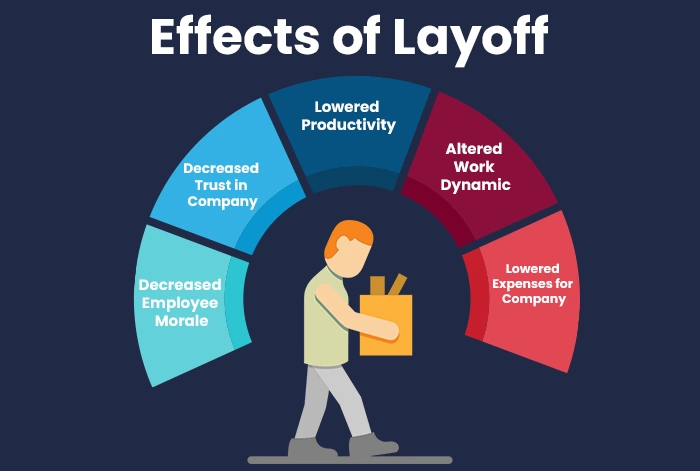
1. Effects of Laid-Off Employees
Surely, the most heavily impacted group in the case of a layoff is the employees who have been let go of by the company. A layoff may lead to several negative effects on such employees’ attitudes, mindset towards the company as well as self-confidence. A few of the potential effects of a layoff on such employees can be:
- Financial Troubles Due to Lack of Pay or Underpayment
- Decreased Morale
- Decrease in Trust in the Organization
- Conflicts with Colleagues/ Dissatisfaction towards Colleagues who have not been laid off
2. Effects on Survivors
When members of a department or team in a company get laid off, the impact is not limited to those who suffer the downsizing but also those who survive it (employees who do not get laid off are referred to as “survivors”). Some of the common effects on the survivors of a layoff include:
- Decreased Morale after layoffs
- Distrust Towards Organization
- Doubt about One’s Tenure
- Lowered Productivity
- Impact on Team Spirit
- Altered Work Dynamic Affecting Productivity
3. Effect on Organisation
The impact on the survivors as well as the loss of a significant proportion of the workforce creates a combined impact on the overall functioning of the company as well. Be it the overall work environment and culture or the productivity and functioning of various units, there can be many effects of a layoff on the company such as:
- New Work Dynamic
- Disbalance of Lines of Work Functioning
- Lowered Productivity
- Lowered Morale of Employees
- Interpersonal Conflicts in the Team
- Distrust between Management and Employees
- Expenses and Newer Costs for Training New Employees and Compensating Laid-Off Employees
Alternatives to Layoffs
While in some cases, a layoff may be the only option available to a company to curb losses and cut expenses. However, in many cases, there might be other alternatives to a layoff that can be considered by companies as it has many detrimental effects on the employees as well as the company, even though it may temporarily help in cutting down expenses.
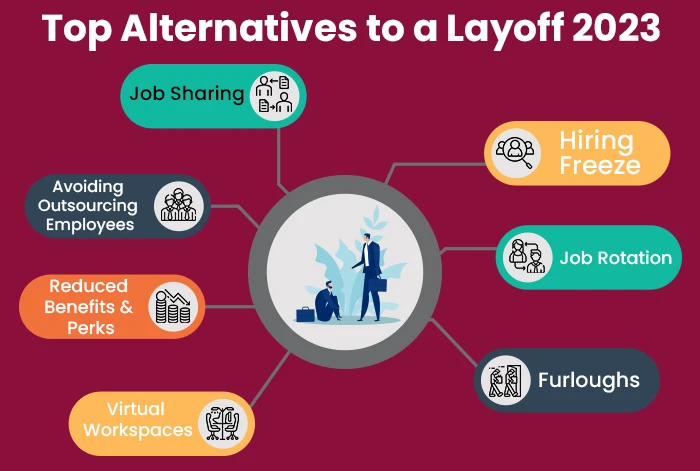
Here are some of the work practices that can be taken up to avoid layoffs or as alternatives to a layoff:
1. Work Sharing
Work sharing involves several employees going through a reduction in their working hours (often temporarily) during economic losses or downturns to cut the company’s expenses and avoid a permanent layoff.
2. Job Sharing
Closely related to work sharing is the practice of job sharing. In a job-sharing arrangement, two or more employees divide the job responsibilities of a job title among themselves so that there is work for all employees to do. The perks, benefits, and pay are often accordingly divided among the employees sharing the job. As a result, the company is able to minimise costs and expenses through this practice and employees do not have to face a layoff.
This practice can be effectively used to avoid layoffs in a situation where a job title becomes redundant or the employer does not have work any longer for certain employees. Such employees can practice job sharing with other employees occupying related job positions to avoid a permanent layoff.
3. Pay Cuts or Reduced Benefits
When a company is facing an economic downturn and wants to cut down its expenses, an effective alternative instead of a layoff could be to provide partial pay or reduced benefits and perks (like insurance cover, allowances, etc.) to the employees temporarily.
Most employees are also likely to settle for reduced pay and benefits temporarily rather than face a layoff in which there is a chance of termination of their tenure. Moreover, it helps the company retain its employees while at the same time minimizing a proportion of its expenses.
4. Hiring Freeze
Most companies that are considering a layoff in their firm also consider a hiring freeze. This can also be used as an alternative to a layoff. The process of hiring new employees is not only very costly but also adds to the burden of affording their expenses as well as the costs of effectively training them on the job. As a result, temporarily freezing new hiring can help the company to cut down substantially on employee expenses and prevent current employees from being laid off.
5. Virtual workspace
This is one of the most feasible alternatives to a layoff. In cases where the major reason for a company to consider a layoff is trying to minimize the costs and expenses, this can be very helpful. Creating a virtual workspace or shifting to a work-from-home arrangement (at least for the majority of the workdays) can help the company cut down on a lot of the expenses involved in maintaining and running an office in the physical mode.
Virtual workspaces can be convenient and easy to run with several technological workspace tools available today to support smooth official functioning. This can allow sufficient flexibility of working to the employees as well as enable the company to cut down on expenses and sustain the workforce without having to go through with a layoff.
6. Voluntary Retirement
In this situation, certain employees, especially those who are nearing the end of their working tenure (i.e. nearing their retirement) can be requested to take a voluntary retirement from work, usually with some compensation package offered to them. Since such employees are already nearing the end of their tenure, taking a voluntary retirement may give them access to a compensation package offered by the company while at the same time preventing the layoff of other employees.
7. Cross Training and Job Rotation
This is a useful measure that can be used by companies to ensure that employees are trained well in a number of related fields and can perform more than one job responsibility and function. Job rotation and cross-training help employees learn about the functioning of various departments or job roles in the company, and this can be helpful in case the company wants to choose a job-sharing practice instead of a layoff.
Cross-training and job rotation help employees stay updated with developments and changing technologies in many cases as well. As a result, the employee becomes a more crucial asset to the employer as well as they perform not one but multiple job responsibilities.
8. Furloughs
Furloughs have already been discussed as one of the alternative practices instead of employee layoffs. In this case, an employee is given a temporary unpaid leave of absence from work until the company needs their services again. However, unlike a layoff, a furlough has more assurance that the tenure of the employee with the company has not ended or won’t be terminated.
They can be a better alternative to a layoff since they mean the employee’s tenure is not finished yet and help the company to reduce expenses in case a job title is not needed currently.
9. Avoiding Outsourcing Labor
This is one of the practices which can help avoid a layoff. Outsourcing a workforce from a second-party agency or company may mean that the requirement for a company’s own full-time employees reduces. As a result, a company may seek a layoff to cut down its extra expenses that are involved with hiring and maintaining its workforce. However, having one’s own workforce is highly useful and has its own pros since it develops an organisational commitment to the company, a work culture and much more.
So, avoiding outsourcing in the organization can help the company avoid the need to lay off its employees.
Explorer Our Popular Articles
|
Explorer Our Popular Articles |
||
Conclusion
If you have read this far, the key takeaway of this discussion is that although not the most recommended approach to handling company functioning or cutting costs, sometimes a layoff can be the only feasible option for an organisation to take up. However, you can take some preliminary measures such as regularly upgrading your skills and technical knowledge, improving your soft skills, and using them to avoid suffering a layoff. And even in the case of an inevitable layoff, there are multiple options available for you to explore and work towards.
FAQs (Frequently Asked Questions)
The most basic difference between a layoff and firing is that a layoff is usually not because of any fault of the employee but due to some reasons on the end of the employer/company. On the other hand, a firing is mainly due to misconduct or under-average performance by the employee. A firing is due to faulty behavior on the employee’s end. Another difference between a layoff and a firing is that the former can be either temporary or permanent whereas the latter means the termination of the employment of the person being fired.
Layoffs can be temporary or permanent, layoffs can be voluntary (either in the form of resignations or voluntary retirement from service), and they can be mass layoffs.
A mass layoff is when the company in question lays off over 500 of its employees in less than the period of a month.
A layoff can be permanent in which case the employee’s employment is terminated by the company. But layoffs can be temporary too, where the employee’s employment is temporarily halted (either with partial pay or without pay) by the company.
No, being laid off in most cases would be due to no fault of yours as an employee and will completely be a company decision due to their own reasons. But in the case of firing, it is usually due to misconduct poor performance, or any other fault of the employee. So, if you are laid off it won’t be considered that you are fired from work.
As an employee, you can avoid a layoff by upgrading your skills and enhancing them regularly, maintaining cordial relations with your colleagues and management, increasing your value to the company, or accepting pay cuts/partial pay/unpaid leave of absence instead of a layoff.
You should grow both your technical skills and soft skills to avoid a layoff. You should regularly upgrade your skills and qualifications to ensure you are an important asset to your company. Moreover, you should improve your soft skills such as communication skills, interpersonal relationships, problem-solving approach, collaboration with others etc. These skills help you stand out among other employees and increase your value to your employer.
In most cases, the company stops paying for your health insurance after you have been permanently laid off. In case of a temporary layoff, the company may continue to pay for your health insurance.
If you have been laid off by your employer, then the next thing to do is to go through your employment contract to see your rights and benefits for the entire procedure. You should also confirm when you get your final paycheck and ask for a letter of recommendation in case your layoff is due to a company reason and no fault of yours.
You should mention a layoff in your resume only when it was not due to any fault of yours. While mentioning it, keep it brief and ensure not to draw too much focus to the layoff. Mention accurate facts and the cause of layoff briefly. For instance, you can mention the layoff briefly as “role eliminated” or “downsizing of the department” etc.

Idea Alchemist / Concept Creator / Insight Generator
We are an online education platform where users can compare 100+ online universities on 30+ X-factors in just 2 minutes. With an active CV community, we have transformed online learning to quite an extent. With the CV Subsidy scheme, we contributing to GER in India while helping our learners with their finances in their “Chuno Apna Sahi” journey!
Every query is essential.
Our team of experts, or experienced individuals, will answer it within 24 hours.
Recommended for you
Tired of dealing with call centers!
Get a professional advisor for Career!
LIFETIME FREE
Rs.1499(Exclusive offer for today)

Pooja
MBA 7 yrs exp

Sarthak
M.Com 4 yrs exp

Kapil Gupta
MCA 5 yrs exp
or



Career Finder
(Career Suitability Test)
Explore and Find out your Most Suitable Career Path. Get Started with our Career Finder Tool Now!
ROI Calculator
Find out the expected salary, costs, and ROI of your chosen online university with our free calculator.

